Formal Balance Is Another Word for Which Type of Balance in Art?
Balance is an of import underlying attribute when it comes to visual compositions; our eyes can naturally spot when an artwork appears off-residual or harmoniously composed; residue signals to us a sense of wholeness. Only in that location are different means in which remainder tin be utilized to give an artwork its grapheme, we will discuss this in more detail in this article along with various residuum in art examples.
Table of Contents
- i What Is Residual in Fine art?
- 2 Types of Balance in Art
- 2.one Symmetrical Remainder
- 2.ii Asymmetrical Balance
- 2.three Radial Residuum
- two.4 Crystallographic Rest
- iii Summary of Balance in Fine art
- four Principles of Art – Further Readings
- 5 Frequently Asked Questions
- 5.1 What Is Residual in Art?
- 5.2 What Are the Different Types of Balance?
- 5.3 How Is Rest Created in Art?
- 5.four What Are the Principles of Art?
What Is Balance in Art?
Rest is part of the principles of fine art, which are also referred to as design principles; these are namely, emphasis, movement, rhythm, proportion, scale, harmony, unity, multifariousness, and contrast. If y'all are not familiar with the principles of art, these act as guidelines or rules, so to say, that assist in composing an artwork into an identifiable format.
Furthermore, an art limerick consists of the diverse art elements, of which there are primarily seven. These are, namely, line, form, shape, color, value, infinite, and texture. All of these elements tin can be combined in thousands of ways according to the principles of fine art.
Permit united states of america await closer at residual in art, which is commonly described as the "visual weight" of an artwork. This can range from painting, sculpture, drawing, or graphic fine art. The "distribution" of the fine art elements is what determines the type of residuum in an artwork.
 The Delivery of the Keys (1481-1482) past Pietro Perugino, Sistine Chapel, Rome;Pietro Perugino , Public domain, via Wikimedia Eatables
The Delivery of the Keys (1481-1482) past Pietro Perugino, Sistine Chapel, Rome;Pietro Perugino , Public domain, via Wikimedia Eatables
Types of Rest in Fine art
There are usually several types of techniques available in each of the principles of fine art. These tin can be utilized in a myriad of ways to utilize the principles more diversely. Therefore, when it comes to remainder in fine art, while there are three primary types of techniques nosotros can apply, some art sources mention four, so nosotros volition discuss the four main types of balance in art below.
Symmetrical Rest
Symmetrical rest is also termed "formal balance" in art, which ways that there is an equal balance betwixt both halves of the visual composition and the images are identical to each other. This blazon of balance in art also includes a "mirroring" of halves, which is referred to as "Inverted symmetry". The composition's halves are separated by the mid-line or otherwise referred to every bit the "central axis". This can exist divided into horizontal, vertical, or diagonal sections.
Therefore, if the composition is separated horizontally, the top and bottom halves would mirror one another, and similarly, with vertical separation, the left and correct halves would mirror one another.
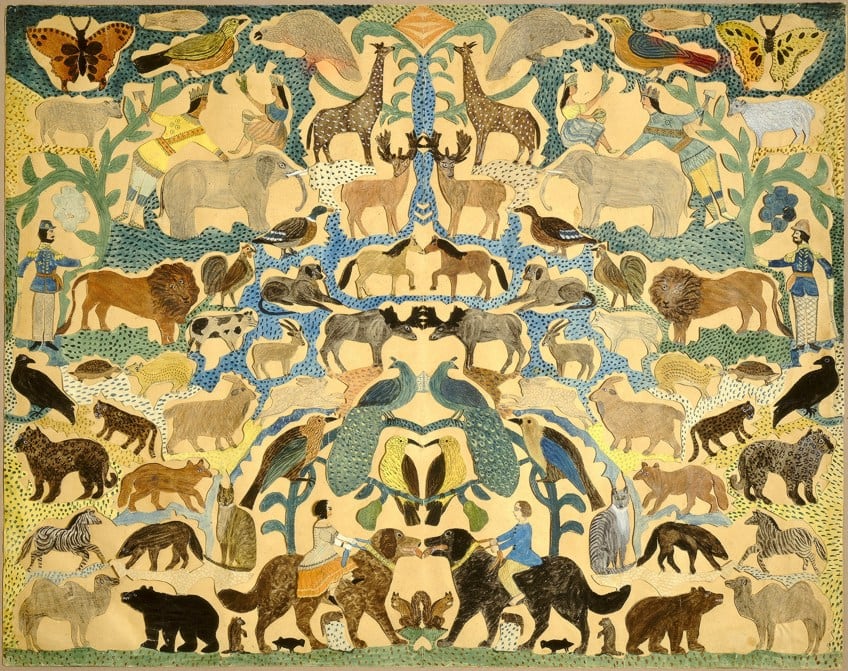 American Cutout of Animals (19th century) by an unknown artist;National Gallery of Art, CC0, via Wikimedia Commons
American Cutout of Animals (19th century) by an unknown artist;National Gallery of Art, CC0, via Wikimedia Commons
Although symmetrical parts of an art composition are ordinarily identical, these can also differ in slight variations, which is referred to every bit estimate symmetry. This is when the parts of both halves exercise not share the same identical or mirroring qualities, although the shapes or sizes may all the same be similar.
Symmetrical balance in visual compositions is widely utilized in art of all modalities.
The common characteristics related to it include a sense of safety, harmony, order, rationality, and stability in artwork, however, information technology can get too boring or monotonous if overutilized. We will find this technique usually utilized in Bookish art from the Renaissance flow when the primary genres for artworks also centered around History and Religious paintings. Symmetrical remainder in art examples includes none other than the famous The Terminal Supper (1495-1498) by Leonardo da Vinci.
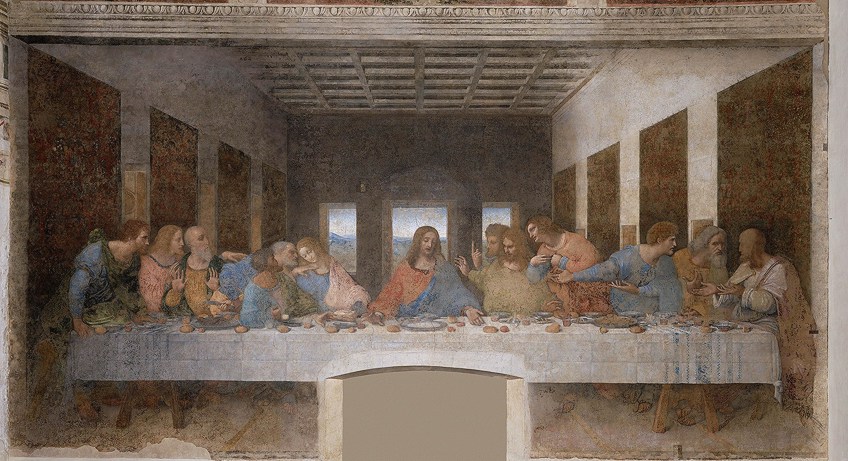 The Last Supper (1495-1498) by Leonardo da Vinci;Leonardo da Vinci, Public domain, via Wikimedia Commons
The Last Supper (1495-1498) by Leonardo da Vinci;Leonardo da Vinci, Public domain, via Wikimedia Commons
In this painting, estimate symmetry is utilized, while virtually of the composition is equal in how the art elements are placed, at that place are differences hither and in that location. For example, the Apostles sitting next to the primal effigy of Jesus Christ are all different, however, the background is rendered in similar shapes on the left and right-hand sides.
Symmetrical remainder does not just occur in paintings, just as well in compages like the Parthenon (432 BC) or the Taj Mahal (1632-1653). In both architectural examples, in that location is an equal placement of architectural structures, especially the columns, which gives it an overall symmetry.
 View of the south side of the Taj Mahal, Agra, India; Yves Picq http://veton.picq.fr, CC By-SA 3.0, via Wikimedia Commons
View of the south side of the Taj Mahal, Agra, India; Yves Picq http://veton.picq.fr, CC By-SA 3.0, via Wikimedia Commons
Symmetrical balance can besides occur biaxially, which means that the limerick is balanced vertically and horizontally. The Op artist Victor Vasarely is famous for utilizing this blazon of symmetry in his artworks, for example, his Vega-Nor (1969), depicts the symmetrical balance of a spherical object on a filigree.
Although the colors are different, these also mirror one another in the iv quadrants.
In other examples like Frida Kahlo's Cocky-Portrait with Thorn Necklace and Hummingbird (1940), there is a feeling of balance because of the central figure of Kahlo and the two nighttime animals, the black monkey on the left and the black true cat on the right, on either side of her shoulders, giving equal weight to her left and right side. Similarly, on her head is a figure of eight bands with 2 butterflies on either side.
 Self-Portrait with Thorn Necklace and Hummingbird (1940) by Frida Kahlo;Ambra75, CC By-SA 4.0, via Wikimedia Commons
Self-Portrait with Thorn Necklace and Hummingbird (1940) by Frida Kahlo;Ambra75, CC By-SA 4.0, via Wikimedia Commons
Maurits Cornelis Escher, otherwise known as Thousand.C. Escher, created geometric abstract artwork, also referred to as tessellations, that appear perfectly balanced using repetition and patterned motifs. Examples include Day and Night (1938), Drawing Hands (1948), and Lizard (1942), among many others.
Asymmetrical Balance
Asymmetrical balance, also called "informal balance", on the other manus, refers to both halves of a limerick retaining a sense of balance, but with different art elements on each side. In other words, both sides take "visual weight" that complements one another to go far almost symmetrical.
The art elements arranged on each side of the composition will range between different colors, forms, shapes, textures, or spaces; for example, one half can appear blackness and the other one-half white, or one shape can be larger than the other shape or shorter and longer.
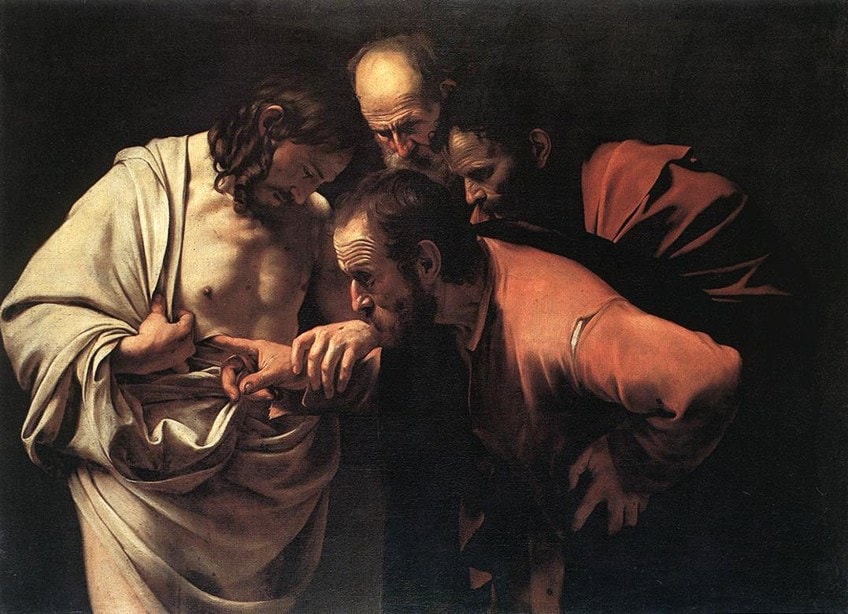 The Incredulity of Saint Thomas (1604) by Caravaggio; Caravaggio, Public domain, via Wikimedia Commons
The Incredulity of Saint Thomas (1604) by Caravaggio; Caravaggio, Public domain, via Wikimedia Commons
Asymmetrical rest in art is likewise described equally beingness more "subjective" compared to symmetrical rest because it requires and involves closer planning to reach the visual weight on each side of the limerick notwithstanding remain various.
Ironically, it can announced more relaxed and unplanned due to the variety in which the fine art elements have been placed.
Asymmetrical balance in art examples includes Vincent van Gogh's The Starry Night (1889), which depicts a tree filling the left-hand side and an emptier right-hand side with only the moon and stars in the dark sky. The placement of these objects creates an overall counterbalanced effect here, the 1 side is darker and heavier in shape than the other side's lighter and smaller shapes, thus playing off one another.
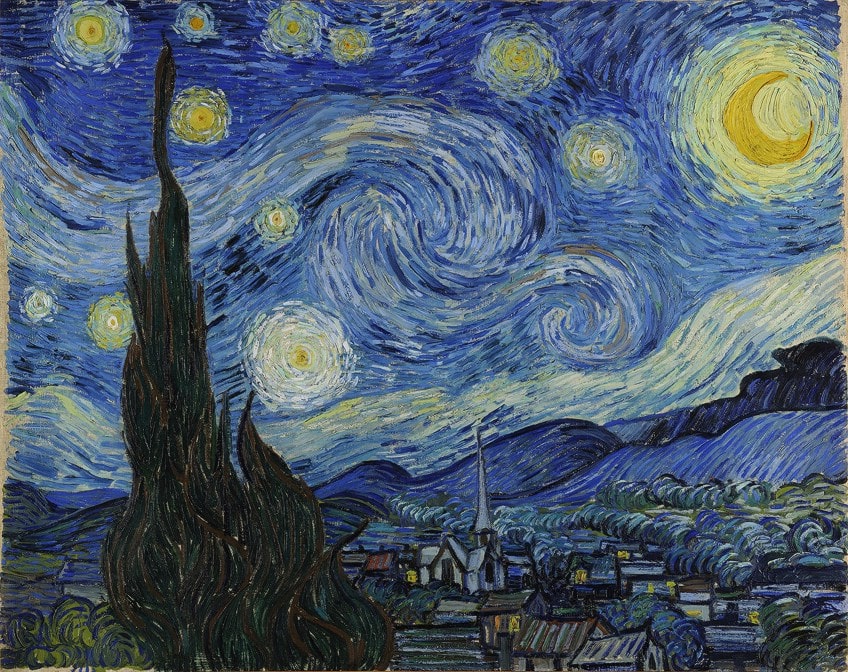 The Starry Night (1889) by Vincent van Gogh;Vincent van Gogh, Public domain, via Wikimedia Commons
The Starry Night (1889) by Vincent van Gogh;Vincent van Gogh, Public domain, via Wikimedia Commons
The more abstracted works past Piet Mondrian from the De Stijl art movement depicts asymmetrical compositions that simultaneously create a sense of harmonious remainder. Artworks include Composition with Red, Yellow, Blue, and Black (1921), in which Mondrian utilized various sizes of shapes, squares, rectangles, and black lines, coupled with areas of primary colors, white, and blackness.
 Composition with Cerise, Yellow, Blue, and Black (1921) by Piet Mondrian; Piet Mondrian, Public domain, via Wikimedia Commons
Composition with Cerise, Yellow, Blue, and Black (1921) by Piet Mondrian; Piet Mondrian, Public domain, via Wikimedia Commons
Across painting, we likewise see asymmetrical balance in three-dimensional sculptures or objects, for example, Alexander Calder'south Mobile (1942). Made from paint and iron, the mobile consists of different sizes of biomorphic shapes. The right side is heavier than the left side and creates stability for the rest of the structure, which thins out and becomes several circular shapes dangling from sparse wire.
The variations of size on both sides of the mobile emphasize its asymmetry, just it creates a harmonious whole, nevertheless.
 Alexander Calder's Mobile (1942) at the Stedelijk Museum Amsterdam, 1969;Eric Koch / Anefo, CC0, via Wikimedia Commons
Alexander Calder's Mobile (1942) at the Stedelijk Museum Amsterdam, 1969;Eric Koch / Anefo, CC0, via Wikimedia Commons
Radial Balance
According to the dictionary, the term "radial" means "developing uniformly around a central axis" or "relating to, placed like, or moving along a radius". A radius is a line from the center of a circular shape or form, like a circle or sphere, to its outer edge or circumference. The word "radius" originates from Latin, and it ways "ray" and "spoke".
Knowing where the term radial comes from will help us understand how radial balance in art is applied. Think of the rays of a light shining outwards or the spokes of a wheel extending to its outer edges.
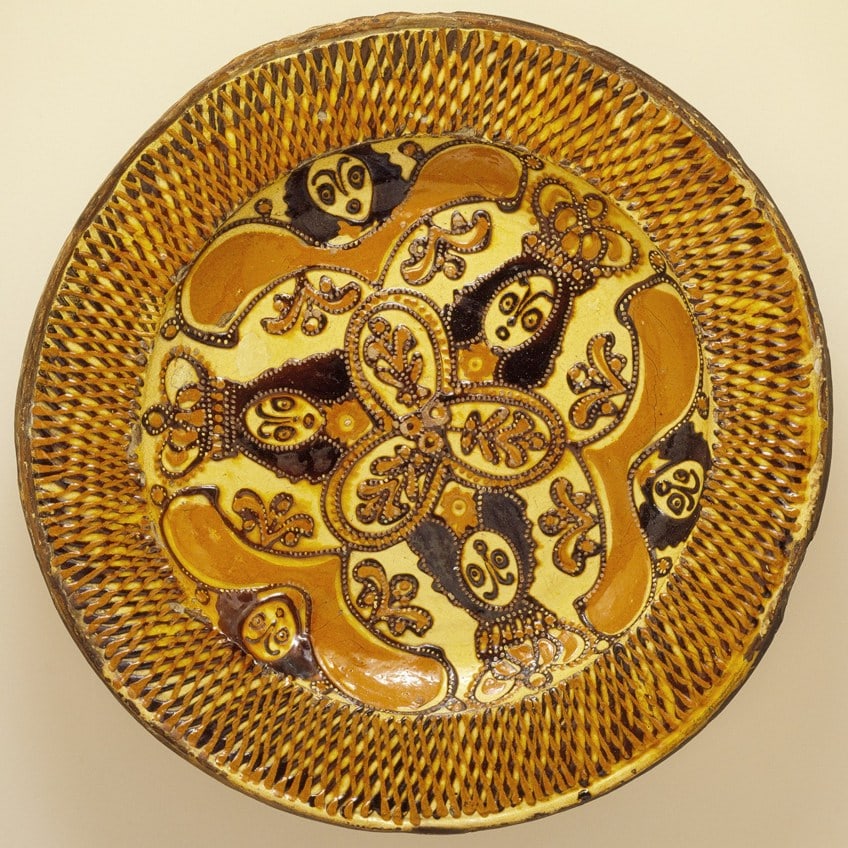 Charger of Charles II in the Boscobel Oak (c. 1685); Los Angeles County Museum of Art, Public domain, via Wikimedia Commons
Charger of Charles II in the Boscobel Oak (c. 1685); Los Angeles County Museum of Art, Public domain, via Wikimedia Commons
Radial symmetry in art involves any fine art element placed around the central point "radiating" outwards. Usually, the art elements would be identical and repeated around this central point, these can range from lines, shapes, forms, colors, or others arranges in a radial design. This blueprint is also recurrent in nature, for example, in flowers, stars, shells, starfish, and many more.
Other examples include spirals utilized to appoint the viewer and lead the gaze to the focal point.
Common radial balance in art examples includes mandalas, of which there are hundreds of different designs and patterns, equally well equally Rose Windows from many Gothic Cathedrals throughout Europe, for case, the Rheims Cathedral, Notre Matriarch, and Chartres Cathedral, all located in France among many others.
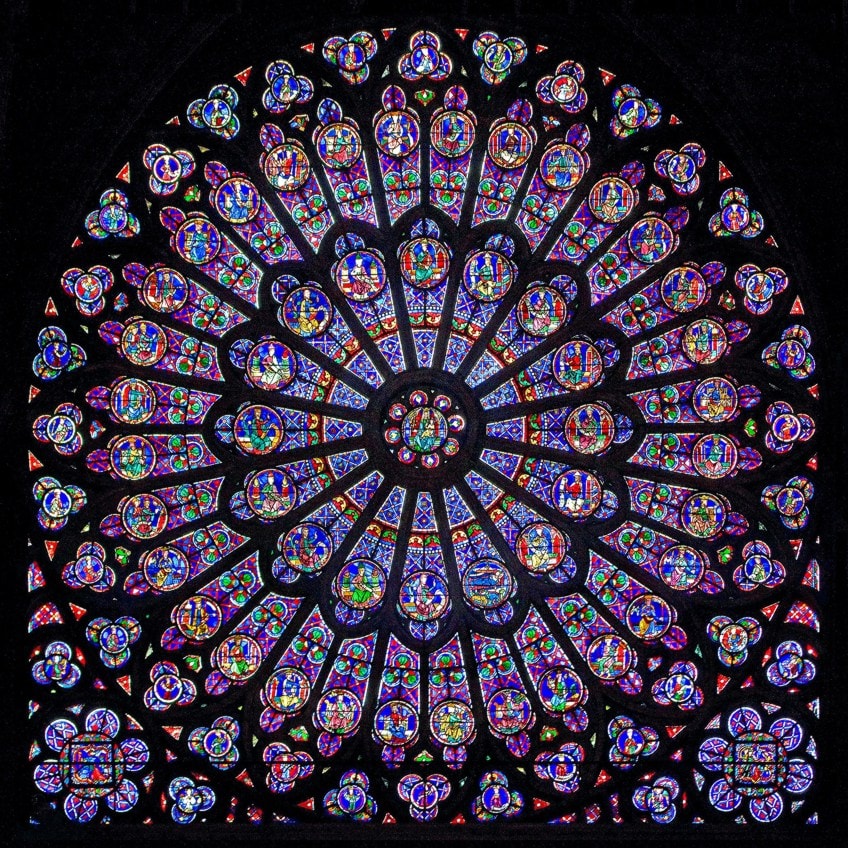 Rayonnant Gothic rose window (north transept) of the Notre-Dame de Paris Cathedral;Zachi Evenor based on File:North rose window of Notre-Dame de Paris, Aug 2010.jpg past Julie Anne Workman, CC BY-SA ii.0, via Wikimedia Eatables
Rayonnant Gothic rose window (north transept) of the Notre-Dame de Paris Cathedral;Zachi Evenor based on File:North rose window of Notre-Dame de Paris, Aug 2010.jpg past Julie Anne Workman, CC BY-SA ii.0, via Wikimedia Eatables
Crystallographic Balance
Crystallographic residue, also termed "mosaic" or "all-over" balance, refers to the more randomized placements of fine art elements. In visual composition, these appear disordered and simultaneously create a sense of social club or harmony; it is often referred to as "organized anarchy".
It is normally recommended that the composition is more packed to appear fuller and thus more than counterbalanced as a result. The viewers' gaze will exist all over the limerick and won't be able to locate a focal indicate.
Crystallographic residual in art examples includes the artworks of Abstruse Expressionist Jackson Pollock. For example, his Number 5 or No. five, (1948) and Fall Rhythm: Number 30 (1950), among many others, all draw his characteristic activity painting process of a variety of paints splattered and strewn across the canvas. When nosotros find Pollock's paintings, our gaze swims in the sea of the unabridged surface area, which is filled to the brim, so to say, with lines and colors.
At that place is no apparent focal betoken and the seemingly chaotic nature of his compositions creates a balancing effect.
Summary of Remainder in Art
| Types of Balance in Art | Characteristics | Artwork Examples |
| Symmetrical rest | It is also referred to as formal balance. When all parts of the limerick are identical or complement one another, both halves of the artwork mirror i another. There can be estimate and biaxial symmetry. | The Last Supper (1495-1498) by Leonardo da Vinci The Parthenon (432 BC) Taj Mahal (1632-1653) Vega-Nor (1969) by Victor Vasarely Cocky-Portrait with Thorn Necklace and Hummingbird (1940) by Frida Kahlo |
| Asymmetrical residuum | It is besides referred to as informal residue. Different fine art elements are used on different sides/areas of the composition but still create a balancing effect. | Limerick with Large Red Plane, Yellow, Black, Gray, and Blue (1921) by Piet Mondrian Mobile (1942) by Alexander Calder The Starry Nighttime (1889) by Vincent van Gogh |
| Radial rest | Refers mostly to round shapes or forms where fine art elements are arranged from the primal point outwards, near like rays of low-cal. | Examples include Mandalas or Rose Windows |
| Crystallographic residual | This is also referred to as mosaic balance or all-over residue. Art elements are more disorganized and randomly arranged all over the visual limerick. | Number five (1948) and Autumn Rhythm: Number 30 past Jackson Pollock |
In this article, we looked at residue in art, what it is and several of the different types that can be applied as techniques, namely, symmetrical, asymmetrical, radial, and crystallographic residue, which is also known as mosaic residuum; artwork examples explored how these techniques have been applied by artists from various fine art periods.
Principles of Art – Further Readings
- Principles of Art main article
- Movement in Fine art
- Emphasis in Art
- Unity in Art
- Rhythm in Fine art
- Texture in Art
- Proportion in Fine art
- Harmony in Art
Balance is one of the principles of art and it works together with the elements of art, which gives it a multitude of methods in which to utilize it. Whether it is lines, shapes, forms, colors, spaces, or textures, balance can give an artwork character, variety, and a harmonious experience. Information technology can be gentle on our eyes or accept our gaze on a wild goose hunt, so to say, either way, residue in art becomes an essential part of an artwork's unified whole.
Oft Asked Questions
What Is Residue in Art?
Balance is one of the principles of art that gives an art composition its then-called visual weight through the system of art elements, namely, line, form, shape, colour, value, texture, and space. The way these are placed in a composition can either make it appear more harmonious or off-balance.
What Are the Different Types of Rest?
There are four main types of residue in fine art, namely, symmetrical balance, which means all art elements are placed in such a fashion where both halves of the limerick are identical to the other, sometimes also mirroring another; asymmetrical balance refers to different elements of art on both halves of the composition, but information technology still creates a sense of balance; radial balance relates to art elements around a round shape or form, and lastly crystallographic, or mosaic, residuum refers to art elements placed randomly or more disorganized, it is also chosen all-over balance.
How Is Balance Created in Art?
Residuum tin exist created in various ways utilizing specific fine art elements, for example, through larger shapes or forms, specially squares or rectangles compared to circles, darker or bolder colors, thicker lines, more texture, equally well as how to utilize the space similar foreground or background placement or along the edges compared to the center of the composition. All the fine art elements interact with one another; therefore information technology is important to sympathize how these will create the so-called visual weight in the artwork.
What Are the Principles of Art?
There are several principles of art, namely, residuum, emphasis, movement, rhythm, variety, unity, harmony, proportion, calibration, and dissimilarity. These are near like guiding principles in how to utilise and utilize art elements similar color, texture, value, shape, course, line, and space.
Source: https://artincontext.org/balance-in-art/
0 Response to "Formal Balance Is Another Word for Which Type of Balance in Art?"
Postar um comentário